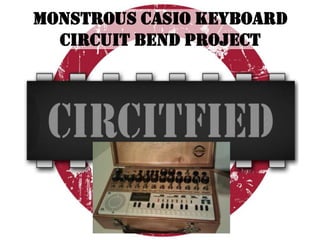Monstrous casio keyboard circuit bend project
- 1. Monstrous Casio Keyboard Circuit Bend Project
- 2. Commission Specifications Commissioned by Hannes Pasqualini from Papernoise Modify a Casio VL-tone to include: ŌĆó A low pass filter ŌĆó Two audio oscillators, with patch bay ŌĆó Voltage starve ŌĆó As many circuit bends as possible ŌĆó Mounted in a customised wooden case
- 3. Selecting a box I had a selection of boxes in my workshop, luckily I managed to find the exact size box that didnŌĆÖt need many modifications.
- 4. Top Panel Demo A wooden insert panel was made using ply wood and cut to size with a disc saw. The knobs were used to keep a scale of perspective. The gap around the edge of the keyboard is 1mm.
- 5. Panel Demo Design I made a quick sketch using word to show how the insert panel would look. AUDIO OUT ON/OFF MOD 1 RESET PITCH MOD 2 PITCH PITCH 1 &2 1&2 POWER PATCH BAY CIRCUIT BEND 1-11 MOD 1 MOD 2
- 6. Panel Design OSCILLATOR A OSCILLATOR B OSCILLATOR A PITCH A Pitch B RESET POWER PITCH OSCILLATOR A MODULATION OSCILLATOR B PITCH FREQUENCY OSCILATOR A OSCILATOR B L.P.F. FEEDBACK STUTTER BASS STUTTER FOLLOWER BASS FOLLOWER The panel design was finalised in power point, the page size was set to the same size as the panel. The file was converted to 16-bit BMP format with the colours inverted. This is so that the file is compatible with the marker laser.
- 7. Box Logo This is the Paper Noise logo. However, I forgot to invert the colours, which meant that I had to make a new plywood panel and re-etch the surface.
- 10. Oscillator Circuit Diagrams I used two oscillators on this keyboard. The first was a Hex Schmitt Inverter Oscillator and the second was a stepped tone generator (atari punk console). Below are the two circuit diagrams I used.
- 11. Low PAss Filter Schematic The low pass filter is a passive design, this means it doesnŌĆÖt need any power to operate, the drawback to this design is that it reduces the output signal by a noticeable amount. The resistor used was a 10K potentiometer, so the frequency could be adjusted.
- 12. Wiring Up
- 13. Completed Box
- 14. Completed Casio
- 15. Casio Video
- 16. Online Projects ŌĆó http://www.youtube.com/user/circitfied?feat ure=mhee ŌĆó http://soundcloud.com/circitfied
















